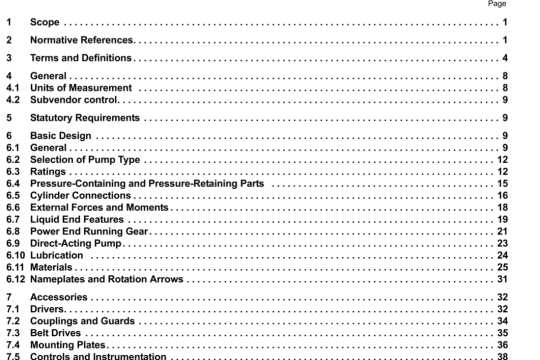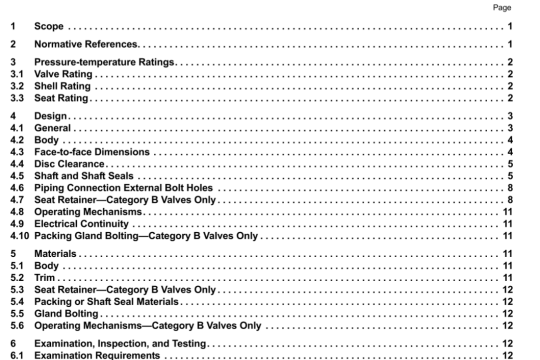API SPEC 7K:2010 pdf download
API SPEC 7K:2010 pdf download.Drilling and Well Servicing Equipment.
5.3 Design Verification Pressure Test
5.3.1 Sampling of Test Units
Each design of pressure-containing items or, as defined in Section 9, primary load-carrying components, where the primary load is pressure, shall be hydrostatically tested for design verification. Hydraulic power transmission components are excluded from this test.
5.3.2 Test Procedure
The test pressure shall be 1.5 times the maximum rated operating pressure. Cold water, water with additives, or the fluid normally used in actual service shall be used as the test fluid. Tests shall be performed on the completed part or assembly before painting.
The hydrostatic test shall be applied for two cycles. Each cycle shall consist of the following four steps:
a) the primary pressure-holding period;
b) the reduction of the test pressure to zero;
c) thorough drying of all external surfaces of the item being tested;
d) the secondary pressure-holding period.
The pressure-holding periods shall not start until the test pressure has been reached, and the equipment and pressure-monitoring gauge isolated from the pressure source. The pressure-holding periods shall not be less than 3 minutes.
5.3.3 Qualification
After each test cycle, the test item shall be carefully inspected for the absence of leakage or permanent deformation. Failure to meet this requirement, or premature failure, shall be the cause for a complete reassessment of the design, followed by repetition of the test.
5.3.4 Individual Parts
Individual parts of the unit may be tested separately if the test fixture duplicates the loading conditions applicable to the part in the assembled unit.
5.4 Design Verification Load Test
5.4.1 General
When required by the specific equipment paragraphs of Section 9, equipment shall be subjected to a design
verification load test.
5.4.2 Sampling of Test Units
To qualify design stress calculations applied to a family of units with an identical design concept but of varying sizes and ratings, one of the following options shall apply.
a) A minimum of three units of the design shall be subjected to design verification load testing. The test units shall be selected from the lower end, middle, and upper end of the load rating range.
b) Alternatively, the required number of test units can be established on the basis that each test unit also qualifies one load rating above and one below that of the selected test unit. (This option would generally apply to limited product rating ranges.)
d) The test unit shall be loaded to the design verification test load.This test load should be applied incrementally,
reading the strain gauge values and observing for evidence of yielding.The test unit may be loaded as manytimes as necessary to obtain adequate data.
e) The stress values computed from the strain gauge readings shall not exceed the values obtained from design
calculations (based on the design verification test load) by more than the uncertainty of the testing apparatusspecified in 5.7.Failure to meet this requirement, or premature failure of any test unit, shall be a cause forcomplete reassessment of the design, followed by additional testing of an identical number of test units asoriginally required, including a test unit of the same load rating as the one that failed.
f) Upon completion of the design verification load test, the test unit shall be disassembled and the dimensions
of each primary load-carrying component checked for evidence of permanent deformation.
g)Individual parts of a test unit may be load-tested separately if the holding fixtures duplicate the loading
conditions applicable to the part in the assembled unit.
5.5Determination of Rated Load
The rated load shall be determined from the results of the design verification load test and/or stress distributioncalculations required by Section 4.The stresses at that rating shall not exceed the maximum allowable stress.Localized yielding shall be permitted at areas of contact. In a unit that has been design verification load-tested, thecritical permanent deformation determined by strain gauges or other suitable means shall not exceed 0.2 % exceptin contact areas. If the stresses exceed the allowable values, the affected part or parts shall be redesigned to obtainthe desired rating.Stress distribution calculations may be used to load-rate the equipment only if the stress valuesdetermined in the analysis are no less than the stresses observed during the design verification load test.




